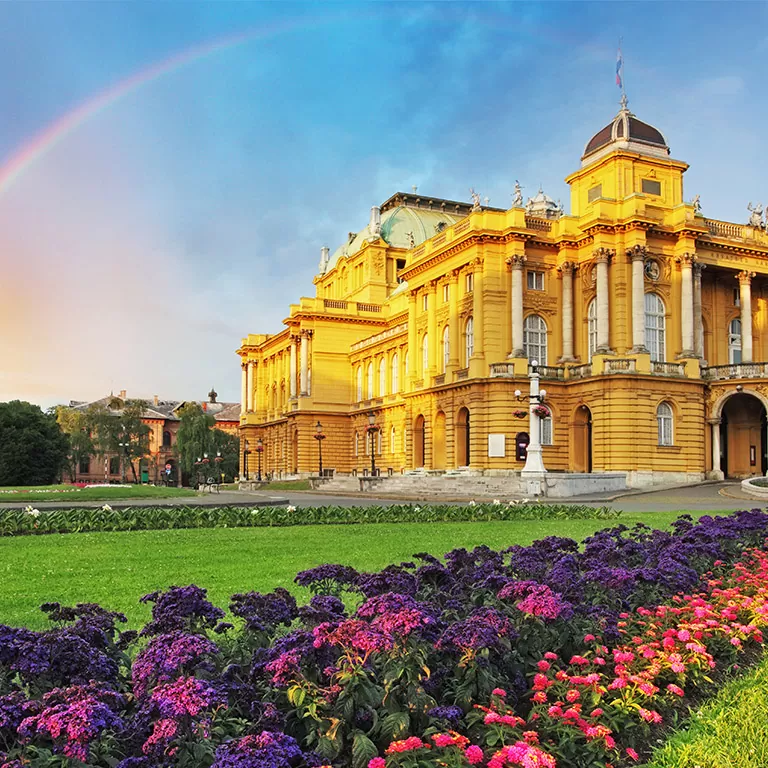
A short time ago, during the finals of the World Cup, the eyes of the whole world were on the capitals of the finalists: Paris, in France, and Zagreb, in Croatia – coincidentally, from one of the most famous to one of the least trendy towns in Europe. Even though, just as in football, it’s difficult to compete with the charms of Paris, the small Croatian town displays charming peculiarities not only for its inhabitants, but also for its visitors.
Zagreb is a tourist destination and also a corridor for Central and Western European tourists on their way to the Adriatic. In spite of its many museums, galleries and monuments, many tourists do not visit Zagreb, going directly to the historical towns of Dubrovnik, Sibenik, Zadar, and others. Zabreg is an important traffic hub, connected to the big European cities and to the Croatian beaches by railways, highways and by air.
Although it’s Croatia’s largest municipality, Zagreb has fewer than 1 million inhabitants – equivalent to only 1/6 of the population of Rio de Janeiro – and is situated between the margins of the Sava River and the slopes of Mount Medvednica, at 120 meters above sea level. The main tourist paths in Zagreb are divided into two parts in the historical center, which can be visited on foot or on a charming tram: the Upper Town and the Lower Town.
Upper Town
Begin by visiting Kaptol Square, famous site of the Cathedral of the Virgin Mary. The building dates from 1899 and has monumental towers that can be seen from practically everywhere in the city. A tour of the interior of the cathedral is really worthwhile, seeing remnants of its medieval structure, torn down by a strong earthquake in the 17th century.
Speaking of towers, go to Lotrscak, the medieval construction that boasts one of the most beautiful views of the town, worth walking up each of its 300 steps. A good tip: visit the tower a little before 12 noon, and hear the boom of one of its cannons announcing that the clock is marking the middle of the day.
With an eye on your watch, visit the Church of Saint Mark, open at times that coincide with the masses celebrated there. One of its biggest attractions is its multicolored roof, one of Zagreb’s symbols. From there, go on to the Croatian Museum of Naïve Art and the Museum of Broken Relationships.
Cross the Stone Gate – or Kamenita Vrata – a medieval gate that has become a sanctuary for Croatians. From there, still in the Upper Town, visit the Tkalciceva, a street with the best restaurants, bars and cafés in the capital. Enjoy the open air tables and the bustle, both on sunny days and trendy nights. Pay special attention to the Medvedgrad and its traditional dishes combined with artisanal beer.
Lower Town
In the so called Lower Town, you’ll find the heart of Zagreb: the Josipa Jelacida Square, famous for its large department stores, bars and restaurants. The same can be said of the Dolac Market, next to the square. For nearly 100 years the Market has been a great place to know the Croatian flavors, tasting dairy products, sausages, and fruit, besides seeing fine handiworks and beautiful examples of local floriculture.
To relax, after you leave the market, go down Zrinjevac, a street with the same name as the most famous park in Croatia, where you’ll find the Croatian Academy of Sciences and Art. Displaying a huge green area, the Zrinjevac Park is surrounded by the most important buildings in Zagreb: from the central train station to the Archeological Museum, as well as the Supreme Court.
A bit smaller, but also displaying the same “green peace”, the Kraja Tomislava Square is a refuge from its bustling surroundings, full of traffic and people. When you tire of all the agitation, visit the lovely Art Pavilion inside the park, and recharge your energy for another tour.











